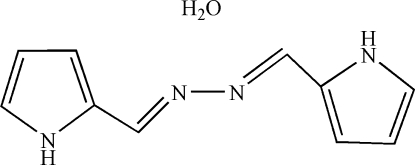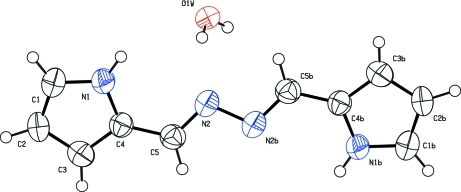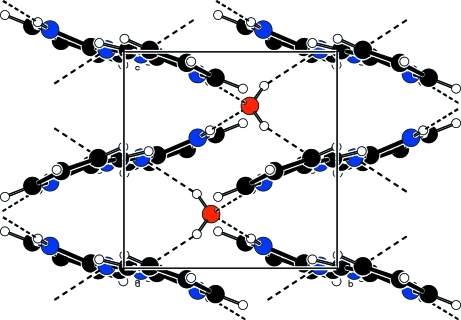Abstract
The molecular structure of title compound, C10H10N4·H2O, has an inversion centre located on the mid-point of the N—N bond of the molecule. A twofold rotation axis passes through the water O atom. In the crystal structure, a two-dimensional network is constructed through N—H⋯O and O—H⋯N hydrogen bonds.
Related literature
For the biological properties of azines, see: Khodair & Bertrand (1998 ▶). For their potential applications, see: Espinet et al. (1998 ▶); Nalwa et al. (1993 ▶); Schweizer et al. (1993 ▶).
Experimental
Crystal data
C10H10N4·H2O
M r = 204.24
Monoclinic,

a = 12.006 (4) Å
b = 6.5806 (19) Å
c = 6.914 (2) Å
β = 105.253 (6)°
V = 527.0 (3) Å3
Z = 2
Mo Kα radiation
μ = 0.09 mm−1
T = 296 K
0.23 × 0.17 × 0.10 mm
Data collection
Bruker SMART CCD area-detector diffractometer
Absorption correction: multi-scan (SADABS; Sheldrick, 2001 ▶) T min = 0.980, T max = 0.991
2143 measured reflections
910 independent reflections
583 reflections with I > 2σ(I)
R int = 0.052
Refinement
R[F 2 > 2σ(F 2)] = 0.065
wR(F 2) = 0.191
S = 1.05
910 reflections
74 parameters
1 restraint
H atoms treated by a mixture of independent and constrained refinement
Δρmax = 0.24 e Å−3
Δρmin = −0.16 e Å−3
Data collection: SMART (Bruker, 2001 ▶); cell refinement: SAINT-Plus (Bruker, 2001 ▶); data reduction: SAINT-Plus; program(s) used to solve structure: SHELXS97 (Sheldrick, 2008 ▶); program(s) used to refine structure: SHELXL97 (Sheldrick, 2008 ▶); molecular graphics: PLATON (Spek, 2009 ▶); software used to prepare material for publication: PLATON.
Supplementary Material
Crystal structure: contains datablocks global, I. DOI: 10.1107/S1600536809025422/at2834sup1.cif
Structure factors: contains datablocks I. DOI: 10.1107/S1600536809025422/at2834Isup2.hkl
Additional supplementary materials: crystallographic information; 3D view; checkCIF report
Table 1. Hydrogen-bond geometry (Å, °).
| D—H⋯A | D—H | H⋯A | D⋯A | D—H⋯A |
|---|---|---|---|---|
| N1—H1A⋯O1W | 0.86 | 2.07 | 2.910 (3) | 167 |
| O1W—H1W⋯N2i | 0.826 (10) | 2.132 (16) | 2.917 (3) | 159 (4) |
Symmetry code: (i)  .
.
supplementary crystallographic information
Comment
Recently, dinucleating diazine ligands containing a single N—N bond have received considerable attention due to their biological properties (Khodair, et al. 1998), their potential applicability in bond formations (Schweizer, et al., 1993), the design of liquid crystals (Espinet, et al., 1998) as well as non-linear optical materials (Nalwa, et al., 1993). we now report the structure of the title compound, (I).
Compound (I) consists of a 1,2-bis((1H-pyrrol-2-yl)methylene)hydrazine organic molecule and a crystal water molecule (Fig.1). The molecular structure of title compound has an inversion centre located on the midpoint of the N—N bond of the molecule. A two-fold rotation axis pass through the water O atom. The N1/C1–C4 ring in (I) is coplanar, in which the C–N bond distances range from 1.344 (4) to 1.377 (4) Å. However, C5—N2 [1.308 (4) Å] is typical for a C═N double bond. The N2—N2b bond distance is 1.395 (5), indicating a N—N single bond.
Two intra and intermolecular hydrogen bonds N—H···O and O—H···N (Table 1) help to establish the molecular conformation, and constructing infinite two-dimensional network along [100] plane (Fig. 2).
Experimental
An ethanol solution containing hydrazine hydrate (0.20 g, 4 mmol) was added dropwise with constant stirring and slow heating to a solution of pyrrole-2-carboxaldehyde (0.38 g, 4 mmol) in the same solvent with five drops of acetic acid. The solution was refluxed for 2 h. Then the resultant solution was filtered. Red crystals suitable for X-ray studies were obtained by slow evaporation of the ethanol solution [yield: 65%].
Refinement
The water H atom was found from a difference Fourier map and refined freely. Other H atoms were treated as riding, with C—H distances of 0.93 Å and N—H distances of 0.86 Å, and were refined as riding with Uiso(H)=1.2Ueq(C and N).
Figures
Fig. 1.
The molecular structure of (I), showing the atom-labelling scheme. Displacement ellipsoids are drawn at the 50% probability level.
Fig. 2.
Two-dimensional structure of (I) along [100] direction. Hydrogen bonds are shown in the dashing line.
Crystal data
| C10H10N4·H2O | F(000) = 216 |
| Mr = 204.24 | Dx = 1.287 Mg m−3 |
| Monoclinic, P2/c | Mo Kα radiation, λ = 0.71073 Å |
| Hall symbol: -P 2yc | Cell parameters from 519 reflections |
| a = 12.006 (4) Å | θ = 3.1–23.4° |
| b = 6.5806 (19) Å | µ = 0.09 mm−1 |
| c = 6.914 (2) Å | T = 296 K |
| β = 105.253 (6)° | Block, red |
| V = 527.0 (3) Å3 | 0.23 × 0.17 × 0.10 mm |
| Z = 2 |
Data collection
| Bruker SMART CCD area-detector diffractometer | 910 independent reflections |
| Radiation source: fine-focus sealed tube | 583 reflections with I > 2σ(I) |
| graphite | Rint = 0.052 |
| φ and ω scans | θmax = 25.1°, θmin = 1.8° |
| Absorption correction: multi-scan (SADABS; Sheldrick, 2001) | h = −14→12 |
| Tmin = 0.980, Tmax = 0.991 | k = −7→7 |
| 2143 measured reflections | l = −8→6 |
Refinement
| Refinement on F2 | Secondary atom site location: difference Fourier map |
| Least-squares matrix: full | Hydrogen site location: inferred from neighbouring sites |
| R[F2 > 2σ(F2)] = 0.065 | H atoms treated by a mixture of independent and constrained refinement |
| wR(F2) = 0.191 | w = 1/[σ2(Fo2) + (0.1036P)2] where P = (Fo2 + 2Fc2)/3 |
| S = 1.05 | (Δ/σ)max < 0.001 |
| 910 reflections | Δρmax = 0.24 e Å−3 |
| 74 parameters | Δρmin = −0.15 e Å−3 |
| 1 restraint | Extinction correction: SHELXL97 (Sheldrick, 2008), Fc*=kFc[1+0.001xFc2λ3/sin(2θ)]-1/4 |
| Primary atom site location: structure-invariant direct methods | Extinction coefficient: 0.06 (2) |
Special details
| Geometry. All e.s.d.'s (except the e.s.d. in the dihedral angle between two l.s. planes) are estimated using the full covariance matrix. The cell e.s.d.'s are taken into account individually in the estimation of e.s.d.'s in distances, angles and torsion angles; correlations between e.s.d.'s in cell parameters are only used when they are defined by crystal symmetry. An approximate (isotropic) treatment of cell e.s.d.'s is used for estimating e.s.d.'s involving l.s. planes. |
| Refinement. Refinement of F2 against ALL reflections. The weighted R-factor wR and goodness of fit S are based on F2, conventional R-factors R are based on F, with F set to zero for negative F2. The threshold expression of F2 > σ(F2) is used only for calculating R-factors(gt) etc. and is not relevant to the choice of reflections for refinement. R-factors based on F2 are statistically about twice as large as those based on F, and R- factors based on ALL data will be even larger. |
Fractional atomic coordinates and isotropic or equivalent isotropic displacement parameters (Å2)
| x | y | z | Uiso*/Ueq | ||
| C1 | 0.1938 (3) | 0.5705 (6) | 0.1197 (5) | 0.0584 (11) | |
| H1B | 0.1862 | 0.4418 | 0.1702 | 0.070* | |
| C2 | 0.1062 (3) | 0.7050 (6) | 0.0509 (6) | 0.0622 (11) | |
| H2C | 0.0287 | 0.6846 | 0.0448 | 0.075* | |
| C3 | 0.1546 (3) | 0.8794 (5) | −0.0091 (6) | 0.0614 (11) | |
| H3A | 0.1152 | 0.9973 | −0.0607 | 0.074* | |
| C4 | 0.2711 (3) | 0.8453 (5) | 0.0221 (5) | 0.0456 (9) | |
| C5 | 0.3587 (3) | 0.9809 (5) | −0.0076 (5) | 0.0489 (9) | |
| H5A | 0.3398 | 1.1158 | −0.0408 | 0.059* | |
| N1 | 0.2931 (2) | 0.6536 (4) | 0.1029 (4) | 0.0499 (9) | |
| H1A | 0.3597 | 0.5962 | 0.1372 | 0.060* | |
| N2 | 0.4646 (2) | 0.9192 (4) | 0.0110 (4) | 0.0481 (8) | |
| O1W | 0.5000 | 0.4090 (5) | 0.2500 | 0.0531 (10) | |
| H1W | 0.487 (3) | 0.342 (5) | 0.343 (4) | 0.055 (11)* |
Atomic displacement parameters (Å2)
| U11 | U22 | U33 | U12 | U13 | U23 | |
| C1 | 0.056 (2) | 0.056 (2) | 0.065 (2) | −0.0124 (18) | 0.0201 (17) | 0.0022 (18) |
| C2 | 0.041 (2) | 0.064 (2) | 0.084 (3) | −0.0099 (17) | 0.0200 (19) | 0.000 (2) |
| C3 | 0.050 (2) | 0.056 (2) | 0.079 (3) | 0.0044 (17) | 0.0179 (18) | −0.0031 (19) |
| C4 | 0.0428 (18) | 0.0454 (18) | 0.0471 (19) | −0.0032 (15) | 0.0095 (14) | −0.0033 (15) |
| C5 | 0.048 (2) | 0.0484 (19) | 0.050 (2) | 0.0017 (15) | 0.0106 (15) | 0.0009 (16) |
| N1 | 0.0400 (16) | 0.0477 (17) | 0.0600 (19) | −0.0018 (12) | 0.0099 (13) | 0.0041 (14) |
| N2 | 0.0531 (18) | 0.0462 (16) | 0.0456 (17) | −0.0090 (12) | 0.0142 (13) | −0.0017 (13) |
| O1W | 0.051 (2) | 0.0377 (19) | 0.074 (3) | 0.000 | 0.0219 (19) | 0.000 |
Geometric parameters (Å, °)
| C1—N1 | 1.344 (4) | C4—N1 | 1.377 (4) |
| C1—C2 | 1.361 (5) | C4—C5 | 1.435 (5) |
| C1—H1B | 0.9300 | C5—N2 | 1.308 (4) |
| C2—C3 | 1.397 (5) | C5—H5A | 0.9300 |
| C2—H2C | 0.9300 | N1—H1A | 0.8600 |
| C3—C4 | 1.376 (5) | N2—N2i | 1.395 (5) |
| C3—H3A | 0.9300 | O1W—H1W | 0.826 (10) |
| N1—C1—C2 | 109.1 (3) | C3—C4—C5 | 129.0 (3) |
| N1—C1—H1B | 125.5 | N1—C4—C5 | 123.9 (3) |
| C2—C1—H1B | 125.5 | N2—C5—C4 | 121.5 (3) |
| C1—C2—C3 | 107.1 (3) | N2—C5—H5A | 119.2 |
| C1—C2—H2C | 126.4 | C4—C5—H5A | 119.2 |
| C3—C2—H2C | 126.4 | C1—N1—C4 | 109.1 (3) |
| C4—C3—C2 | 107.7 (3) | C1—N1—H1A | 125.4 |
| C4—C3—H3A | 126.1 | C4—N1—H1A | 125.4 |
| C2—C3—H3A | 126.1 | C5—N2—N2i | 110.9 (3) |
| C3—C4—N1 | 106.9 (3) |
Symmetry codes: (i) −x+1, −y+2, −z.
Hydrogen-bond geometry (Å, °)
| D—H···A | D—H | H···A | D···A | D—H···A |
| N1—H1A···O1W | 0.86 | 2.07 | 2.910 (3) | 167 |
| O1W—H1W···N2ii | 0.83 (1) | 2.13 (2) | 2.917 (3) | 159 (4) |
Symmetry codes: (ii) x, −y+1, z+1/2.
Footnotes
Supplementary data and figures for this paper are available from the IUCr electronic archives (Reference: AT2834).
References
- Bruker (2001). SAINT-Plus and SMART Bruker AXS Inc., Madison, Wisconsin, USA.
- Espinet, P., Etxebarria, J., Marcos, M., Péres, J., Remón, A. & Serrano, J. L. (1998). Angew. Chem. Int. Ed. Engl.28, 1065–1066.
- Khodair, A. I. & Bertrand, P. (1998). Tetrahedron, 54, 4859–4862.
- Nalwa, H. S., Kakatu, A. & Mukoh, A. (1993). J. Appl. Phys.73, 4743–4745.
- Schweizer, E. E., Rheingold, A. L. & Bruch, M. (1993). J. Org. Chem.58, 4339–4345.
- Sheldrick, G. M. (2001). SADABS Bruker AXS Inc., Madison, Wisconsin, USA.
- Sheldrick, G. M. (2008). Acta Cryst. A64, 112–122. [DOI] [PubMed]
- Spek, A. L. (2009). Acta Cryst. D65, 148–155. [DOI] [PMC free article] [PubMed]
Associated Data
This section collects any data citations, data availability statements, or supplementary materials included in this article.
Supplementary Materials
Crystal structure: contains datablocks global, I. DOI: 10.1107/S1600536809025422/at2834sup1.cif
Structure factors: contains datablocks I. DOI: 10.1107/S1600536809025422/at2834Isup2.hkl
Additional supplementary materials: crystallographic information; 3D view; checkCIF report




